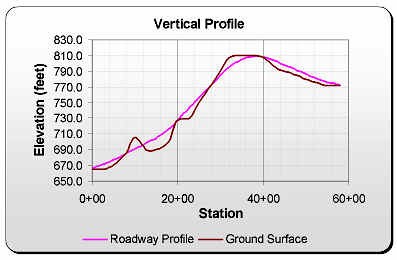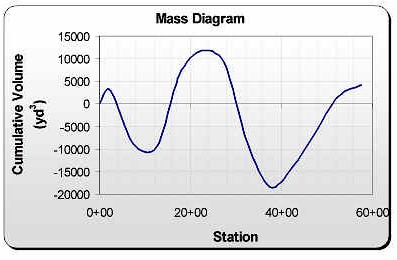
Earthwork
One important aspect of roadway design is determining the amount of
earthwork necessary on a project. Earthwork includes the excavation of existing earth
material and any placement of fill material required for constructing the embankment. The
manual method for determining earth excavation and embankment amounts involves three
steps: cross sections of the proposed highway are placed on the original ground cross
sections, the areas in cut and the areas in fill are calculated, and the volumes between
the sections are computed. Cut and fill are the terms that are usually used for the areas
of the section; the terms excavation and embankment generally refer to volumes. The
methods used to manually calculate cut and fill areas are presented in most surveying
textbooks.
Mass diagrams (or mass-haul diagrams) are plots of the cumulative volumes of cut and
fill along an alignment. Typically, the mass diagram is plotted below a profile of the
route, with the ordinate at any station representing the sum of the volumes of cut and
fill up to that station. An example of a mass diagram is shown below, with its associated
profile. Steps used to create a mass diagram are presented in the Excel demonstration
included with this page. The most economical way to handle the distribution of earthwork
volumes can be determined from the diagram.


The rising curve on the mass diagram indicates excavation and a descending curve
indicates embankment. If a horizontal line is drawn to intersect the diagram at two
points, excavation and embankment (adjusted for shrinkage) will be equal between the two
stations represented by the points of intersection. Such a horizontal line is called a
balance line, because the excavation balances the embankment between the two points at its
ends.
Since the ordinates represent the cumulative volume of excavation and
embankment, the total volumes of excavation and embankment will be equal where the final
ordinate equals the initial ordinate. If the final ordinate is greater than the initial
ordinate, there is an excess of excavation (as shown in this mass diagram); if it is less
than the initial ordinate, the volume of embankment is the greater and additional material
must be obtained to complete the embankment. Highway engineers strive to balance the
amount of cut and fill during a highway construction project to avoid costly hauling of
materials.
|